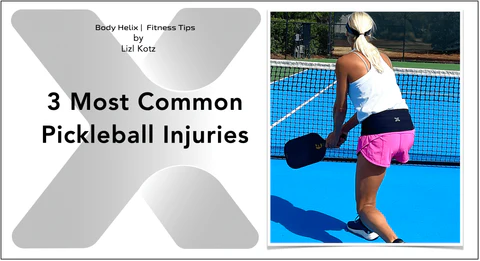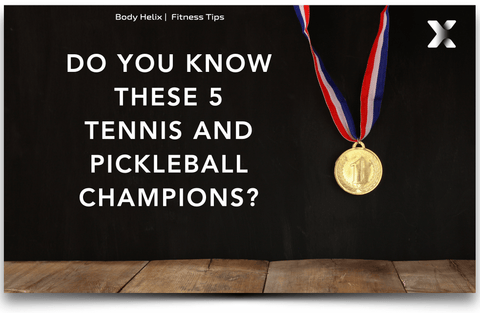Pickleball, what is the fascination with this “new” sport? Why are tennis players finding this sport so inviting? How quickly can a National Tennis Champion become a high-ranked contender? Let’s consider a few tips from the world of pickleball.
NEVER SERVE AND VOLLEY
DON’T BANG THE BALL
RETURN AND GET IN

The Professional Pickleball Association (PPA) North Carolina Open was held in Charlotte this past week. Our newest Ambassador, Lizl Kotz, won the Gold Medal in Mixed Doubles 5.0 level 19+ age group with partner Greg Dow (both from Charleston, SC). Congratulations! This is an excellent example of how tennis players can quickly and successfully transition to the sport of pickleball. In the Men’s Pro Singles Championship, two stand-out tennis players, Ryan Sherry (Gators) and Julian Arnold (UCLA) faced off in a great battle, with Sherry taking the Gold.
I was fortunate to attend this event in person and watch these fabulous players. Also, I got to see doubles and mixed doubles matches and distinguished the distinctive tactics between singles and doubles. And being a newbie to the sport myself, I decided to enter this tournament – more about that later.
Unfortunately (or fortunately), my learning strategy involves falling on my face — repeatedly! It’s been effective. For those of you who don’t know the story, my first tennis experience was a ‘headfirst’ approach, although I was not sure I used my head. Does trying out for a college tennis team on my first day ever playing the sport make me a bonafide idiot? I didn’t even know how to keep score. Innumerable lessons, hundreds of tournaments, and a few decades later – now full of wisdom and sophistication – I have a new approach.
I watched YouTube videos of pickleball matches this time around and took a couple of lessons. Yes, I had a few less-than-graceful losses. I bought a paddle, found opponents, and had fun! After a few days (literally), I figured it was time to enter a tournament. The night before, I did my prep work and googled how to keep score. This was my new-and-improved headfirst approach. Hey, at least when I fall on my face, I’m moving forward!
Pulling from my tournament experience, I elected to play only singles in the PPA tournament. This strategy paid off for me. In my first-ever pickleball event, winning the Men’s Singles 60+ age group level 4.0, Gold Medal confirms this entry point is doable for top-level tennis players. I want to share some learnings I had while participating in my first pickleball tournament.
Racquet players, especially tennis players, have a bit of an edge versus a novice. The transition from tennis to pickleball is relatively easy for tennis players. They already have solid racquet skills, excellent hand-eye coordination, and explosive court speed. Playing pickleball singles is closer to tennis singles than pickleball doubles is to tennis doubles. While doubles play is more commonplace, I recommend singles for seasoned tennis players, as a starting point. But first, there are a few things tennis players will need to get out of their systems before advancing in pickleball.
PICKLEBALL RULES - NEVER SERVE AND VOLLEY
This is instinctual in tennis. It’s what we do. New to pickleball tournaments, you might think that a player would be able to smother the net on this smaller court. Not so, my friends. The “kitchen” or no-volley zone is center stage. This 7’ x 22’ area at the net is a no-fly zone for tennis players. You can’t take the ball in the air in the kitchen, which completely shuts down your serve and volley game. And yes, I was repeatedly reminded that I was not supposed to do this, while crushing some volleys.
After the ball has bounced once in each player’s court, both players may either volley the ball or play it off a bounce (ground stroke). The double bounce rule eliminates the serve and volley advantage and extends rallies.

PICKLEBALL TIP - DON’T BANG THE BALL
In tennis, many players bring the skills to hit aggressive shots. When our opponents are at the net, we tennis players immediately react by ripping a passing shot. In pickleball singles, this can be effective. However, for doubles players, it is not a solid tactic. Pickleball is essentially a “soft game.” Since the player can’t step into the kitchen and take the ball in the air, the best choice is to hit a touch shot landing in the kitchen. The player must wait and let it bounce. This usually diffuses the big bangers. And you get an opportunity to get up to the volley line yourself.
First to the volley line is always a good thing. In pickleball doubles, you’ll see most points played with all four players right up on the volley line, unlike singles, where many points are tactically played one up and one back. Moving from tennis to pickleball and back and forth means changing your power output. Playing pickleball may help tennis players better understand the difference between soft, drop, finessed and angled shots. Mastering touch shots and the no-volley zone require speed, nimbleness, and focus.
RETURN AND GET IN
In pickleball, servers only get one chance (no second serve), so their serve can’t be too risky. The server must let the returned ball land before hitting the next shot. In singles, the best return-of-serve strategy is to return the ball and immediately move up to the volley line. Having a great return of serve is a weapon. When returning, try to put as much distance between your opponent and the net as possible. Likely the server will put the serve deep at the baseline, so your goal, as the returner, is to do the same.
The benefit to hitting the return deep is that it gives you the time and momentum to start heading towards the kitchen. Remember, the harder you hit the pickleball, the faster it is returned. In doubles, you will often see a dink on the third shot. In singles, the receiver will try and rip it by you. The receiving team/player usually gets up to the volley line first, which helps them with court position advantage.
I hope these few tips are helpful for those of you interested in exploring this sport. I initially thought pickleball was a non-movement sport. I was wrong. It’s fast-paced – physically and mentally. The overall stamina and agility required for pickleball are on the same level as tennis. There’s a considerable difference between tennis racquets and pickleball paddles, pickleballs and tennis balls, court size, net size, and shot execution. In pickleball, the paddles are smaller, the balls don’t bounce as high, and the court is smaller, yet the same basic principles of movement from tennis apply.
Just like tennis or any sport, training and injury prevention are integral in pickleball. I’ve seen knee, lower back, and hamstring injuries due to quick actions as well as crouching and lunging movements. And the overall time-on-court at events (back-to-back match play) results in players becoming dehydrated, which can exacerbate muscle injuries.
So, what is the fascination with this “new” sport? Why are tennis players finding this sport inviting? How quickly can an accomplished tennis player become a high-ranked contender? I will let you know as I continue to figure it all out. I will also be bringing you news on equipment, rules of pickleball, and more information on the game of pickleball. In future blogs we will look at highly accomplished tennis players (and even Wimbledon Champions) who have switched to pickleball. I'll feature more tips for exercises, injury prevention, and tactics. Stay tuned for further advice so you can stay healthy, improve your fitness, and cultivate your skills.
Learn. Share. Inspire.
Be well, my friends.
Coach Fred



